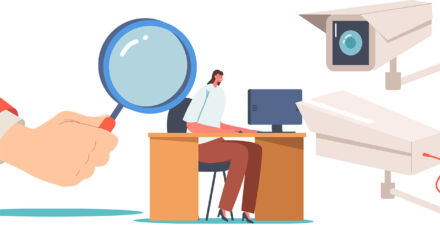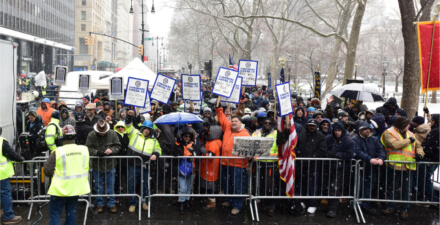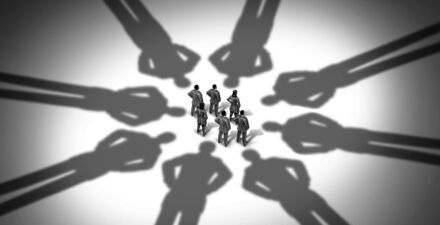New workplace surveillance bill would protect U.S. workers and address new technological risks

Across the U.S. economy, the risks posed by unchecked automated surveillance and management technologies are widespread—and growing. These technologies can sometimes be beneficial for workers, customers, and businesses alike. For instance, GPS tracking devices paired with panic buttons can help keep hotel housekeeping staff safe when facing possible harassment or assault. AI-powered cameras also can help proactively identify potential health and safety risks involved in operating heavy machinery and alert workers before they hurt themselves.
But automated surveillance and management technologies can pose risks to workers’ physical and mental health and undermine workers’ rights under equal opportunity, labor, and employment laws. Such risks are already playing out across the U.S. economy. Take these two examples, cited in responses to a recent White House Request for Information on Automated Worker Surveillance and Management,1 from workers in very different sectors of the economy: a call center at a financial institution and an Amazon.com Inc. warehouse:
“I spent 7 years working in a call center at a financial institution doing customer support, sales, and retirement planning … a huge amount of data was collected about my activities throughout the day … [electronic monitoring of time spent “on task” meant that] people went to great lengths to stay on schedule … if you got a call from your kid’s school or your bank, you couldn’t simply sign out and take the call. I and almost everyone I knew there frequently held our bladders for an uncomfortably long time because we didn’t have a break scheduled … I would not be able to do that job today. Due to the strictness of the adherence policy, and its incompatibility with a number of health conditions, pregnant people, single parents with young kids, and disabled people did not last long in these job roles.”
“I was a seasonal Amazon warehouse employee in 2019 at the Rialto, California fulfillment center … My Amazon job was the most physically and mentally exhausting job I have ever had. I walked in on my first day excited to be working there, but the joy quickly faded because of the model of working until you are hurt, driven by the use of technology to constantly track worker productivity … the surveillance system constantly monitors worker productivity, how many items we pack per second and per hour. If you have not scanned or moved a box for a couple of minutes, the system alerts a manager … It is really stressful and physically demanding to keep up … They never told us if we were making rate, so you are never really sure how well you are doing. Managers just told us to keep going. The pressure forces workers to work faster and faster.”
These vivid accounts illustrate how employers are increasingly using workplace surveillance to track workers’ activities and productivity. Researchers, responding to the same White House RFI, also drew attention to how faulty surveillance technologies can inadvertently discriminate against workers with disabilities if, for example, automated productivity tracking does not permit sufficient accommodations for workers whose disabilities affect their performance on such tracking schedules.
These technologies are being used by employers not only to surveil workers on the job but also to chill union organizing efforts and single out and discipline workers who take collective action. Cornell University researcher Kate Bronfenbrenner, for instance, finds that the use of surveillance by employers to monitor or investigate organizing drives has more than doubled over the past 20 years—and the use of such technologies is associated with lower union success rates.
While we lack gold-standard estimates of the prevalence of automated surveillance and management technologies because the federal government does not regularly collect such information and employers are not required to report the use of such technologies, suggestive evidence points to widespread adoption across different sectors. According to a 2022 investigation by The New York Times, eight of the 10 largest private U.S. employers tracked individual workers to assess their productivity.
Additionally, recent research cited in responses to the White House RFI by two labor scholars found that more than half of workers surveyed in the retail, warehousing, and telecommunications industries reported that their managers electronically monitor their productivity on the job. And, in a 2021 study, the worker-power-building nonprofit Coworker documented how the worker surveillance vendor market is large and growing.
Read collectively, the evidence indicates that the risks posed by automated surveillance and management technologies are large—and likely will continue to grow.
New legislation introduced by Rep. Christopher Deluzio (D-PA) in the U.S. House of Representatives—the Stop Spying Bosses Act—would take important steps to protect workers against misuses of automated surveillance and management systems and ensure these technologies are not used to undermine workers’ rights. The proposed law—which complements parallel legislation introduced in the U.S. Senate by Sens. Bob Casey (D-PA), Cory Booker (D-NJ), and Brian Schatz (D-HI)—also would create new capacity in the federal government to regulate new and evolving workplace technologies and their impacts on the U.S. workforce.
The bill takes three important steps forward. First, it would require employers to disclose to workers and the general public any workplace surveillance being conducted, including what is being collected, how it is being collected, the purposes for which it is being used (including if it will affect employment-related decisions), and whether the collected information is being transferred or sold to other entities. Employers also would need to share with workers when they make decisions on the basis of surveillance technologies and give workers a chance to contest those decisions if they were made erroneously—a critical step, given the many reports of workers being penalized on the basis of faulty automated decisions.
These disclosures would clarify for workers how their employers are using technology, helping to address the uncertainty that many workers feel about monitoring. Such uncertainty can create a chilling environment for workers as they fear taking actions that might trigger a backlash from their employers even if they are legally protected, such as actions in support of forming a union. These disclosures also would help the government, labor organizations, and researchers piece together a clearer picture of how prevalent automated surveillance and management technologies are in different industries and occupations, and study their adoption across firms.
Second, the bill would explicitly bar employers from using workplace surveillance to collect and act on certain types of information. Notably, employers could not use automated surveillance to single out workers who are trying to exercise their rights to form, join, or support a labor union or engage in collective workplace action. Nor could employers use surveillance technologies to collect health or disability information unrelated to workers’ jobs. And employers could not use surveillance to monitor workers while they are off-duty—an especially important provision, given concerns about employer surveillance of remote work that might be done in a worker’s home.
These protections for workers would provide, for the first time, explicit federal limits on employer surveillance and data collection and analysis. As it stands now, there is only a patchwork set of similar protections that vary across agencies, states, localities, and sectors of the U.S. economy.
Third, the bill would create a new office within the U.S. Department of Labor responsible for enforcing this law, including by conducting investigations, coordinating with other enforcement agencies in the federal government, and issuing new regulations. The proposed new office would be led by a new administrator, who could hire staff with expertise in technology, privacy, and labor issues and who could regularly consult with outside experts.
Creating a new federal office with an explicit mandate to enforce the provisions of this law would go a long way to building the capacity within the federal government to address the risks that automated surveillance and management presents. This step also would help keep the government responsive to new and evolving risks from such technologies in the future.
There are good reasons to consider bolstering existing enforcement capacity around labor issues, too, both as part of new legislation such as the Stop Spying Bosses Act and as part of the regular appropriations that the U.S. Congress provides to the federal government. U.S. Department of Labor subagencies, such as the Wage and Hour Division and the Occupational Safety and Health Administration, face the herculean task of enforcing protections for workers with limited resources and inspectors. The Wage and Hour Division, for instance, has around 1,400 employees protecting a workforce of more than 165 million U.S. workers.
The Wage and Hour Division and Occupational Safety and Health Administration could use existing laws to regulate the impacts of automated surveillance and management technologies, such as the extent to which workers’ health and safety is threatened in ways that could cause death or serious physical harm, or whether hourly workers are not paid for the work they perform. Yet these agencies have other competing priorities, making it challenging for them to tackle additional activities, which is why added capacity, staff, and resources would help address the negative effects from workplace surveillance and automated management technology.
Another action not included in the Stop Spying Bosses Act that would complement its objectives is support for the National Institute for Occupational Safety and Health—the primary federal research agency studying worker safety and health. Added support for this agency would enable it to investigate the issues that automated surveillance and management systems pose to workers’ well-being. High-quality research could then help inform enforcement and regulatory activities by the federal government, such as new Occupational Safety and Health Administration standards.
Even so, the Stop Spying Bosses Act is a much-needed step forward that would protect workers from employer surveillance and bolster the federal government’s ability to regulate the use of management technologies. Addressing the harms and risks posed by workplace surveillance would be good for workers’ well-being without removing the benefits that some technology can offer.
Did you find this content informative and engaging?
Get updates and stay in tune with U.S. economic inequality and growth!
End Notes
1. The document compiling all public comments in response to the White House RFI is no longer publicly available. See White House, “Public Submissions: Request for Information: Automated Worker Surveillance and Management” (2024).






